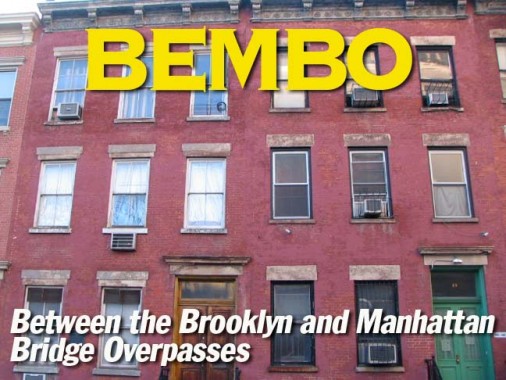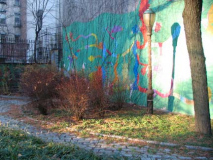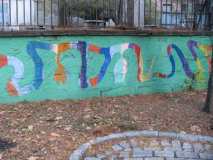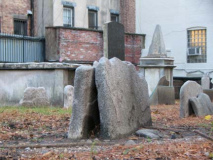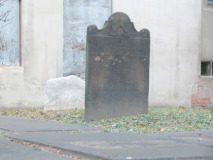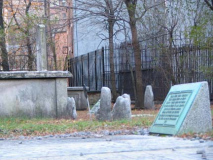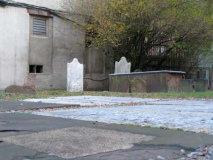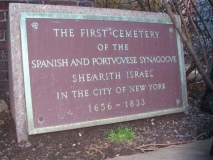You’ve all heard of DUMBO, the formerly forbidding part of Brooklyn that’s Down Under The Manhattan and Brooklyn Bridge Overpasses. The Mother Borough also has its own area between the bridges, and, with apologies to the venerable typefont, I have dubbed it BEMBO, or Between the Manhattan and Brooklyn Bridge Overpasses. Original, I know. Manhattan’s area between the bridges, unlike the well-preserved DUMBO, has been decimated through the years by demolition of the old tenements and construction of the Al Smith Houses, named for one of the region’s brilliant lights. In FNY tradition, I’ll concentrate on the old stuff.
GOOGLE MAP: Between the Manhattan and Brooklyn Bridge Overpasses
Walking on Pearl Street under the Brooklyn Bridge approaches from South Street Seaport, you’ll find a broad, wide open vista, with the Al Smith Houses on your right (bordered by Robert F. Wagner Senior Place, named for aUS Senator and father of the three-term NYC Mayor in the 1950s and 1960s, and the well-protected NYPD Headquarters on your left, punctuated by the Avenue of the Finest. Pearl Street seems to mysteriously change names just up ahead to St. James Place (actually a now-closed section of Pearl Street wanders northwest and then west to Foley Square).
While this is now a windswept, wide-open area, until the 1960s it was a rabbit warren of tiny streets, none of which led anywhere. The Bowery, which begins at Chatham Square, was extended south to meet Pearl Street in 1856, cutting through the heart of a tenement-dominated, tightly packed gridiron. Of the list of streets that included Oak, Roosevelt, Batavia, New Chambers, Chestnut, and New Bowery itself, none of them is in existence today with the exception of New Bowery, renamed St. James Place (for historic St. James Church on James Street) in 1947. A 1913 New York Times article goes into detail about this now-vanished corner of downtown Manhattan.
Passing James Street on St. James Place, you find a desultory little patch of green, locked behind a gate, with a winding path, a lone lamppost that casts a dramatic shadow on a winter afternoon, and a mostly green mural, “Flowering Vein,” completed in 1997 by Pamela Crimmins (so its inscription says.) The Parks Department sign indicates that it’s St. James Square (lots of James place names are clustered here) named for the venerable Catholic church on James Street (referenced in the link above). The park was created in 1961 when a parking garage and tenement were torn down. The land was donated by financier Bernard Baruch.
Behind the far wall of St. James Square, though, is something really interesting….
…that very rare Manhattan sighting, a vest pocket cemetery. Besides Trinity Church’s two cemeteries, one downtown and one uptown in Hamilton Heights at West 155th Street, there are three smaller ones, all belonging to the Shearith Israel Spanish and Portuguese Synagogue. (There are many, many hidden and buried cemeteries around town, such as the 1990 discovery and newly renovated African Burial Ground near Federal Plaza; a previously buried tombstone was unearthed in Washington Square during its renovations in 2009.)
This, the oldest extant cemetery in Manhattan, was founded in 1682 by Shearith Israel, NYC’s first Jewish congregation.
During Peter Stuyvesant’s era, Shearith (“Remnant of”) Israel was the city’s only Jewish congregation, founded by exiled Spanish and Portuguese Jews in 1654. While the Dutch colony of New Amsterdam permitted freedom of faith, a novelty in that era, public synagogues were not permitted until several decades later, with Shearith founding the first of its five temples in 1730 (their present one is on West 70th Street). Shearith Israel’s first cemetery was founded at what became the Wall Street area in 1656, and while that one is long vanished, this one, dating to 1682, is still here, and contains the oldest tombstone in the city (Benjamin Bueno de Mezquita), dated 1683.
While I’ve never seen the gates open, I did see Barry Lewis wandering around therein during a PBS special, but the redoubtable NYC chronicler has connections, bwana, connections. You can, however, get some decent pictures by poking the camera through the fence and zooming in. There are luminaries here — 18 Revolutionary War soldiers and patriots, including one of the 14 clergymen to officiate at President Washington’s inauguration, Rabbi Gershom Mendes Seixas: his preaching had made such an impression that in 1789 he was asked to deliver sermons at St. Paul’s Chapel (which still stands at Broadway and Vesey Street), and officiated at the inaguration a year later. This was an early example of ecumenism in the nascent nation.
As Shearith Israel moved gradually uptown it established two other cemeteries. A small slice of the first, on West 11th Street near 6th Avenue, is still there, as is the second, on West 21st west of 6th. They make surprising discoveries for people who were unaware that cemeteries exist in Manhattan.
A 2-block stretch of Oliver Street remained after the 1950s, when the Al Smith Houses complex was built; Oliver was named for Oliver deLancey, brother of James deLancey, owner of most of the Lower East Side during the colonial era. The mighty Mariner’s Temple dominates Oliver Street between St. James Place and Henry Street. It was built in 1845 as the Oliver Street Baptist Church and became the Mariner’s Temple in 1863, ministering to seamen and immigrants. Things have come full circle — it’s now the Mariners’ Temple Baptist Church. As you can see, its Greek Revival brownstone exterior is a little worse for wear and could use some renovation.
The row of small buildings on Oliver Street’s west side — Nos. 19 through 27 — appears untouched, as in unrenovated and not maintained much — since Berenice Abbott photographed them in 1937. At #25 a plaque announces that this was the house where Al Smith, the Happy Warrior, four-term New York State Governor and 1928 Democratic Presidential candidate — spent some of his boyhood years. I remember my grandmother telling me how she listened to the radio on Election Day 1928 hoping against hope that Smith would be elected the nation’s first Roman Catholic President.
We’ve just scratched the surface — plenty more historical locales in BEMBO, where Chinatown meets the Lower East Side, and we’ll try to get to more on future FNY pages.
Photographed December 7, 2009; page completed December 10, 2009
